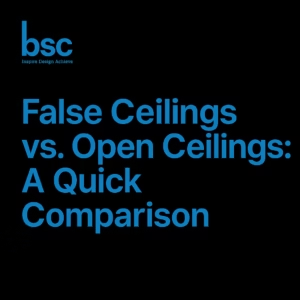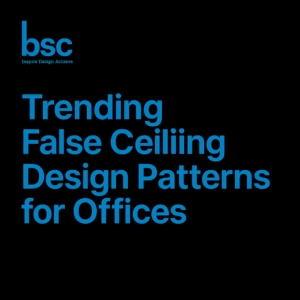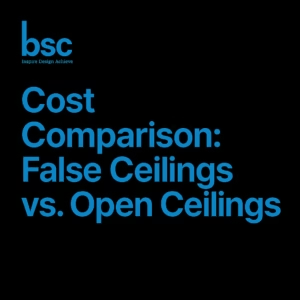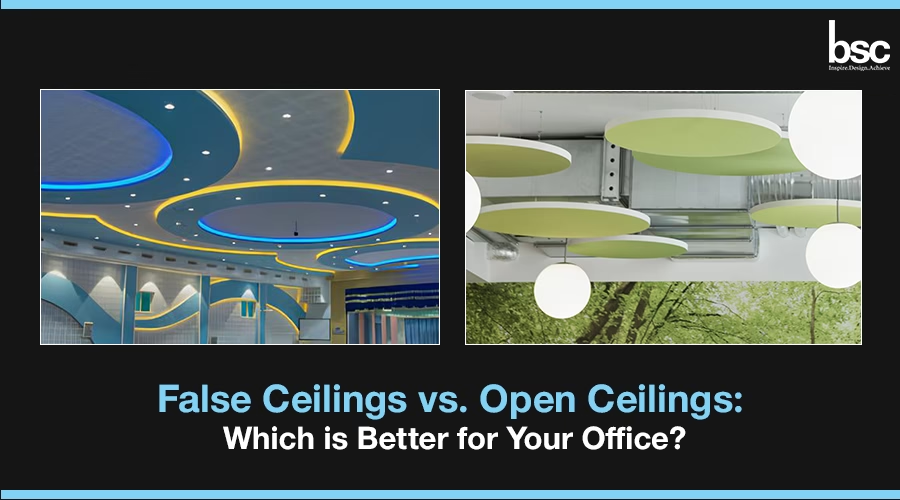Enter your office and look up, what do you see? When you first enter, is the ceiling a smooth, hanging ceiling trellis that looks calm and orderly – or a bold and open ceiling with pipes, ducts and metal beams that tell a story of contemporary brilliance? That second glance up can subtly affect your perception, productivity and even your company’s identity.
In this blog, we’ll take your knowledge beyond aesthetics to the next level. You’ll discover the hidden costs, acoustic surprises, energy considerations, design secrets and long-term maintenance for both false (suspended) ceilings and open (exposed) ceilings. By the end, you’ll be well-equipped to decide which option looks better and performs better for your office environment.
Want to know how ceilings affect comfort, budget, branding and functionality? Scroll down – the ceiling above can tell you more than you ever thought.
Introduction: Why Ceiling Choice Matters for Modern Offices
When designing or renovating an office, most people think about flooring, lighting or furniture. But one thing that is often overlooked is the ceiling – and it makes a huge difference in the look, feel and functionality of your workplace.
The style of ceiling you choose can affect the following:
- Brand identity and overall look
- Acoustic comfort and noise levels
- Energy efficiency and heating/ventilation and air conditioning (HVAC) costs
- Ongoing and long-term costs
Two Popular Choices in Modern Offices
False Ceilings (Suspended/Drop Ceilings):
- Covers wiring, ducts, structural components
- Ensures a clean, uniform, professional look
- Provides more effective sound absorption and insulation
Open Ceilings (Exposed Plenum):
- Exposes rough beams, pipes and ductwork
- Creates an industrial, contemporary and open atmosphere.
- Allows for greater height and design versatility
Beyond Just Looks: The Real Debate
Cost Factor:
- Open ceilings may seem more economical, but there may be some hidden costs in finishing, painting and cleaning.
- False ceilings may cost more to install, but there will be savings on energy bills due to lesser amounts of cold or hot air.
Acoustics & Comfort:
- False ceilings reduce noise and are therefore suitable in call centres, meeting rooms and corporate areas.
- Open ceilings are known to increase noise and additional acoustic solutions are required.
Why This Matters for You
Your roof isn’t just about what’s above your head, it also has a direct impact on:
- Employee productivity (comfort and noise control)
- Customer perception (the extent to which your office looks modern and professional)
- Operational costs (energy savings vs. maintenance costs)
What Is a False Ceiling?
It is usually made from gypsum board, plaster of Paris (POP), PVC or mineral fiber panels. This type of design is decades old, but it first became popular in the mid-20th century because of it’s ability to hide wiring, ducts and structural beams as well as improve the overall appearance of the interior.
Key Features of a False Ceiling
- Services Conceals: Conceals electrical wiring, air conditioning ducting, fire extinguishers and pipes.
- Improves appearance: Provides a structured, formal and attractive look.
- Improves sound: Absorbs sound and reduces noise in busy offices.
- Thermal insulation: Saves energy by reducing cooling/heating loads.
- Design flexibility: Can be moulded into contemporary forms, curves or overlay designs.
Common Applications in Commercial Interiors
False ceilings have become a common feature in modern offices, retail stores, hotels and schools due to their aesthetic and practical uses. Some of it’s practical uses are:
- Corporate offices: Design soundproof meeting rooms and workspaces that look clean.
- Conference halls: Combine lighting, projectors, and sound panels.
- Reception areas: Create a strong first impression using attractive ceiling designs.
- Workplaces: Minimize noise distractions and improve employee focus.
- Shopping showrooms: Display products with built-in lighting.
Why Offices Prefer False Ceilings
It is a versatile design solution that increases comfort, reduces operating costs and creates a contemporary professional image. This practicality and style makes false ceilings one of the best choices in office architecture today.
What Is an Open Ceiling?
 Open ceiling is a building design in which the building’s structural and mechanical components, such as beams and ductwork, wiring and pipes, are exposed (not enclosed behind a false ceiling), rather than hidden. It has become popular in contemporary offices, coworking spaces and creative studios because of it’s industrial and spacious look.
Open ceiling is a building design in which the building’s structural and mechanical components, such as beams and ductwork, wiring and pipes, are exposed (not enclosed behind a false ceiling), rather than hidden. It has become popular in contemporary offices, coworking spaces and creative studios because of it’s industrial and spacious look.
Unlike smooth and neat-looking false ceilings, open ceilings emphasize the rough structure of the room and make it appear open and elevated.
Key Features of an Open Ceiling
Exposed structural features: Ducts, beams, and pipes are exposed and usually painted or finished to make them look pretty.
- High ceilings: Makes the area feel open and more spacious.
- Industrial-modern look: This look is common in startups, creative agencies, and technology centers.
- Future modification allowance: Easy access to ducts, wiring, and fixtures that can be modified or renovated.
Common Applications in Commercial Interiors
Startups and coworking offices: To create a cozy, teamwork atmosphere.
- Artistic studios: To keep it trendy and artistic.
- Retail stores: Especially in showrooms where height and style are an important focus.
- Tech offices: To establish an ultra-modern, futuristic effect.
- Cafés/restaurants: For a loft-like, industrial style.
Why Offices Choose Open Ceilings
Open terraces are best suited where aesthetics and a sense of space are of utmost importance. They transform spaces and make them appear larger and more active, while also promoting an urban, hip brand image.
However, they may require additional investment in acoustic treatments and HVAC systems, which businesses should take into account when making a decision.
False Ceilings vs. Open Ceilings: A Quick Comparison

When choosing between a false ceiling and an open ceiling, any business should consider four key factors: design, acoustics, energy and cost. Both styles have their own advantages and the right choice usually depends on the type of office, budget and brand name.
Design Flexibility
- False ceilings: These offer countless design options, such as layered or geometric lighting, cove lighting, or patterned. They enable modern lighting fixtures to be integrated and provide a seamless, smooth look.
- Open ceilings: However, design flexibility is mainly limited to lighting styles, paint finishes, or open duct arrangements.
Acoustic Performance
- False ceilings: Good at reducing sound. Sound absorption is possible in gypsum, mineral fibre and acoustic tiles, which is why these are best suited for a busy office or meeting room.
- Open ceilings: These do not have good natural sound control. More panels or hanging absorbers or acoustic barriers are required to reduce echo and noise.
Energy Efficiency
- False ceilings: Eliminate the area requiring air conditioning or heating and improve HVAC performance and reduce utility costs.
- Open ceilings: In open ceilings, more air escapes, so additional air volume has to be conditioned, resulting in increased energy consumption.
Cost and Maintenance
- False ceilings: more expensive to install initially, but easier to maintain as ducts and wires are not visible. Additional panels are not expensive.
- Open ceilings: may be less expensive initially, but require regular finishing, painting and acoustic treatment. Since the components are exposed, they are difficult to maintain.
Trending False Ceiling Design Patterns for Offices

The following are the most popular options being used by businesses nowadays:
- Gypsum board ceilings – beautiful and flexible, can be layered, curved or made into geometric shapes. Ideal for offices where a sleek look is desired.
- Cove lighting ceilings – use indirect LED lighting built into the edges of the ceiling, providing a soft, contemporary light to work areas.
- Wooden finish ceilings – offer a homely charm and natural feel, which would be appropriate in a conference room or creative studio.
- POP (plaster of Paris) designs – lightweight and customisable, and are used to create logos or brand-related patterns as part of the ceiling.
These styles not only enhance beauty, but also add acoustic properties, energy-saving properties and branding.
Modern False Ceiling Design for Bedrooms vs. Workspaces
While many people look for false ceiling designs for bedrooms, there are notable differences between bedroom and office ceilings:
- Bedrooms: Designs are usually focused on comfort and ambiance. They feature cove lights, smooth curves and decorative patterns. The aim is comfort.
- Workspaces: Function and performance come first. Designs prioritize acoustic panels, minimal patterns, and energy-saving lighting integration. The goal is productivity.
Types of False Ceilings
The type of false ceiling you use when designing a contemporary office interior plays a key role in striking a balance between aesthetics, acoustics, durability and cost. Below is a description of the most commonly used options:
Gypsum False Ceiling
- Features: Lightweight, glossy and can be used in suspended or layered designs.
- Advantages: Excellent soundproofing, fireproof and ability to create curved or modern designs.
Why Popular in Offices? They feature hidden lighting, brand-based designs and an effortless professional look that adds to the corporate interior.
PVC False Ceiling
- Benefits: It is very strong, waterproof, termite resistant and easy to clean.
- Cost Factor: More budget-friendly than gypsum.
Comparison with Gypsum:
- PVC → It is most economical, low maintenance and durable.
- Gypsum → Better for high-end, design-focused spaces with acoustic needs.
POP (Plaster of Paris) Ceilings
- Highlights: Lightweight and highly customizable.
- Strength: Can create artistic shapes, company logos, or decorative patterns.
- Best Use: Offices looking to add creative flair in lobbies, reception areas, or meeting rooms.
Metal & Mineral Fiber Ceilings
- Metal Ceilings: Metal ceilings are strong and fire resistant and can be used in industrial or high-performance commercial areas.
- Mineral Fiber Ceilings: These are acoustically controlled, thermally insulated and inexpensive. Common in large offices and auditoriums.
False Ceiling Material List
A brief comparative description can be seen here:
- Gypsum boards – versatile, smooth, modern.
- PVC panels – low cost, low maintenance.
- POP sheets – lightweight, decorative.
- Metal tiles – heavy industrial.
- Mineral fibre boards – acoustic, low cost.
Brand-Specific Solutions: Gyproc False Ceiling Catalogue

Gyproc (Saint-Gobain brand) is one of the most reputed brands in the industry when it comes to false ceiling designs. Their offerings are highly sought after in corporate offices, retail stores and commercial interiors as they offer a balance between aesthetics, performance and durability.
Gyproc false ceiling catalogue PDF is a useful tool that helps any architect, designer and business owner to choose the appropriate system to be installed in that space.
What Does the Gyproc Catalogue PDF Include?
The Gyproc catalog is not a product catalog, but rather a complete design and specification guide. It typically includes the following:
- Material information – gypsum board, tiles and systems.
- Design inspiration – patterns, textures and modular ceiling layouts.
- Performance ratings – fire resistance, thermal control and acoustic ratings.
- Installation instructions – step-by-step instructions for contractors and installers.
- Applications – suggestions for offices, auditoriums, conference rooms and lobbies.
This makes it easier for businesses to compare solutions before investing.
Popular Gyproc Product Lines for Commercial Interiors
Gyproc offers solutions that are in high demand, such as:
- Gyproc plain and laminated gypsum boards – for a clean and modern finish on ceilings.
- Gyptone acoustic ceilings – perfect for meeting rooms or open-plan offices, these ceilings are designed with perforations to improve sound absorption.
- Casoprano ceiling tiles – tiles made of mineral fabric that have excellent acoustics and a high-quality appearance.
- Rigitone boards – acoustic boards with modern performance.
How to Choose from the Gyproc Catalogue for Your Office
The following are some of the aspects to consider when viewing Gyproc false ceiling catalogue PDF:
- Aesthetics → Choose smooth gypsum boards or designer tiles in customer-facing areas.
- Acoustics → When you need to control noise in your office, use Gyptone or Rigitone.
- Durability – Laminated and waterproof boards are best suited for long-term performance.
- Budget → Allocate the product range according to your investment level (budget: normal gypsum, high-end: acoustic boards).
You can check the catalogue from the official website of Gyproc.
Cost Comparison: False Ceilings vs. Open Ceilings

In the design or renovation of an office, a false ceiling or open ceiling is usually decided based on cost. Each solution has it’s own financial benefits, not only in installation, but also in long-term maintenance and energy efficiency.
Installation Cost Breakdown
False Ceilings:
- These will require metal framework, panels, and skilled labor to install, so the initial cost will be higher than leaving the ceiling exposed.
- Despite this, false ceilings allow for easy installation of lighting, HVAC ducts, and wiring, saving additional finishing costs.
Open Ceilings:
- The initial cost will be lower as the building is not enclosed.
- Industrial grade paint, caulking and other insulation will be required to make the space usable.
- Open ceilings can be left untreated and, as a result, can often be aesthetically enhanced.
Maintenance & Replacement Costs
False ceilings
- Less cleaning and panels need to be replaced when damaged. PVC and gypsum ceilings are particularly low maintenance.
Open ceilings:
- Exposed ducts, beams and wires can accumulate dust and debris, so these need to be cleaned regularly. Utility repairs are also very costly and troublesome.
ROI for Different Office Types
Corporate Offices & Call Centers
- False ceilings save energy (less air volume to cool/heat), resulting in lower electricity bills.
Creative Studios or Warehouses
- When aesthetics and flexibility are prioritized over operational costs, open ceilings may be a better option.
Acoustic Performance: Which Ceiling Works Best?
One of the biggest distractions at the workplace, which has a direct impact on productivity and employee well-being, is noise. The choice between a false ceiling and an open ceiling has a profound impact on noise management.
Noise Control in False Ceilings
- False ceilings are used as sound barriers that help reduce echoes and absorb sound.
- Gypsum, mineral fibre and acoustic tiles are materials that are designed to provide soundproofing.
- Acoustic panels or perforated boards can be integrated into the office for better noise reduction and are therefore suitable for meeting rooms, auditoriums and call centres.
Sound Issues with Open Ceilings
- Open ceilings expose ducts, pipes and beams, creating hard reflective surfaces.
- Sound is released and causes reverberation, echoes and increased noise levels.
- Even small sounds (conversation, typing or phone calls) are exaggerated, and it is difficult to find solitude or concentration.
- This may also require additional acoustic treatments, such as hanging baffles or acoustic clouds, which are more expensive.
Case Studies: Call Centers vs. Creative Agencies
- Call centers: High noise and speech intelligibility. False ceilings with acoustic panels are very efficient and satisfying for employees.
- Creative agencies: Open ceilings can be effective when the team wants a loft-like work environment. Still, more acoustic solutions can be used to avoid distractions.
You can check also our acoustic ceiling tiles from here.
Energy Efficiency & Lighting Impact
Businesses are concerned about energy consumption as it has a direct impact on operating costs. False ceilings and open ceilings are two options that can have a profound impact on heating, cooling and lighting in an office.
How False Ceilings Reduce HVAC Load
- The use of false ceilings reduces the vertical height of the room, which reduces the amount of air that must be handled by HVAC systems.
- This directly results in a reduction in cooling and heating energy consumption.
- Other insulating materials such as gypsum boards and mineral fibre tiles are also used to insulate walls and other structures, which helps to further reduce energy losses.
Lighting Design with Suspended Ceilings
- In offices, with well-planned layouts, savings can also be made on the number of devices used, without compromising on lighting.
- Indirect lighting also eliminates glare on screens, making employees more comfortable.
Open Ceilings and Energy Inefficiency
- Open ceilings allow for greater air volume, which puts more load on the HVAC system.
- Exposed ducts and pipes may need to be more insulated to avoid energy leakage.
- Lighting designs can be more complex and involve suspended lighting or track lighting, which can increase installation and energy costs.
Aesthetics & Workplace Vibes
The look and ambiance of an office has a profound impact on employee morale and customer perception. As such, the choice between a false ceiling and an open ceiling depends on design preferences and brand identity.
Sleek Uniformity of Suspended Ceilings
- These can be made as per custom designs (patterns, textures and built-in lighting) and can be used in corporate offices, board rooms and customer-centric spaces.
- These provide a professional, clean environment that increases productivity at the workplace.
Industrial Chic of Open Ceilings
- Open ceilings leave beams, ducts, and pipes exposed, creating a rough, industrial look.
- They create the illusion of height and spaciousness that is typical of contemporary, creative, and startup offices.
- The industrial vibe fits well with coworking settings, studios, retail spaces, and tech offices that want to look trendy and unconventional.
Balancing Modern Looks with Functionality
- False ceilings are highly functional with built-in acoustics, lighting and HVAC efficiency.
- Open ceilings offer beauty and transparency at the expense of comfort, noise and energy consumption.
- The new generation of offices uses a mix of these two styles: false ceilings in functional areas (conference rooms) and open ceilings in collaborative areas (lounge or brainstorming areas).
Maintenance & Durability
When choosing between a false ceiling and an open ceiling, you should not only consider the installation but also the long-term maintenance and durability. The right choice should be the one that has the least cost in the long term.
Maintenance in False Ceilings
- Tiles are easy to replace: When a portion of a ceiling is stained, damaged or worn, only the tile needs to be replaced, not the entire ceiling.
- Easy access: False ceilings are made of removable panels, allowing technicians to access HVAC ducts, wiring or sprinklers without damaging the building.
- Dust protection: Pipes and ducts are enclosed so they don’t collect as much dirt as an open ceiling, requiring less frequent cleaning.
- Strength is a factor in the material: Gypsum, PVC or mineral fibre all have different life spans. PVC is waterproof, gypsum is strong but requires maintenance, and mineral fibre is good for sound but may need frequent replacement.
Maintenance in Open Ceilings
- Regular painting: Exposed beams, ducts and pipes may require periodic painting to keep them aesthetically pleasing.
- Visible dust and dirt: All items are exposed, so dust easily accumulates and needs to be cleaned frequently.
- Complicated repairs: Although access is straightforward, the visible nature of the repairs may cause problems in design or working conditions.
Decision Guide: Which Ceiling Is Right for Your Office?
False ceiling or open ceiling depends on how you shape your office design according to your budget, brand image and functional needs. This decision-making model can help in the following:
Checklist for Choosing the Right Ceiling
- Budget: False ceilings may cost more upfront, but will save on energy and maintenance.
- Acoustics: False ceilings are better in offices that have quiet areas (such as conference rooms or individual cabins). Open ceilings tend to amplify noise.
- Energy efficiency: Suspended ceilings reduce HVAC loads and feature built-in lighting. Open ceilings increase cooling and heating requirements.
- Aesthetics and branding: False ceilings create a corporate, professional image while open ceilings create a creative, modern and industrial image.
- Maintenance: Replacing tiles vs. repainting open buildings – consider long-term maintenance costs.
Use-Case Scenarios
- False Ceilings Fit Best For: Corporate offices, boardrooms, IT firms, healthcare sectors and customer-centric environments.
- Open Ceilings Fit Best For: Startups, co-working centres, design studios, cafes, stores and showrooms
Real-World Examples
Considering real examples of false ceilings and open ceilings gives decision makers an idea of how both options work in practice. These designs are used in various industries according to their preferences – from branding to functionality.
Offices with False Ceilings
- Corporate Workplaces: Large IT companies and MNCs prefer to install false ceilings as these provide a glossy and professional look..
- Hospitals and Healthcare Centres: Gypsum or PVC false ceilings are commonly used in hospitals as these are hygienic, moisture resistant and easy to maintain. These can also support hidden ducts and air distribution.
- Educational Institutions: Their acoustic benefits reduce noise levels and help in concentration.
Offices with Open Ceilings
- Startups: Many startups opt for open ceilings because they have an industrial and modern feel. They are innovative and adaptable as well as less expensive to build.
- Co-working Spaces: These hubs aim to look trendy and casual.
- Creative Studios: Design, media and advertising companies often adopt open ceilings to portray a cool and progressive brand image.
Implementation Tips for Office Ceilings
It requires more than just a beautiful ceiling design; it must be well planned, professionally installed, and long-lasting. Below are some key tips for a successful implementation.
Choosing the Right Contractor
- The ceiling contractor should have experience in dealing with false ceilings and open ceiling systems.
- Verify their portfolio, certifications, and source of materials to avoid poor quality.
- When you hire a reliable contractor, it will help you avoid designing issues like acoustics or misplaced HVAC.
Planning HVAC & Lighting with Ceilings
- False Ceilings: Coordinate with HVAC and electrical. Grids should be installed on the ceiling where air vents, lighting fixtures and fire sprinklers are located. LED panels can be installed in suspended ceilings and save energy.
- Open Ceilings: Keep ducts, pipes and cables organized, as these will be visible..
Additional Tips
- Design with future maintenance in mind.
- To reduce noise in open ceilings, it is advisable to install acoustic barriers or sound-absorbent panels.
- Select the ceiling (gypsum, PVC, mineral fiber, etc.) according to regional weather and application requirements
Future Trends in Ceiling Design
The future of ceiling design is rapidly changing as the workplace demands sustainability, flexibility, and intelligence. False ceilings as well as open ceilings are being redesigned using modern technologies and green solutions.
Sustainable Ceiling Materials
- Companies are starting to use eco-friendly materials like recycled gypsum board, mineral fiber panels, and low-VOC PVC options.
- Sustainable offices are also turning to bamboo, wood wool, and acoustic cotton panels. These not only reduce the carbon footprint but also improve indoor air quality.
- With LEED and IGBC-certified projects, the demand for more eco-friendly ceiling solutions is on the rise.
Smart False Ceilings with IoT Integration
- False ceilings using IoT are transforming the workplace environment. Occupancy, temperature and air quality can be monitored using integrated sensors, and HVAC and lighting can be optimized to reduce overhead.
- Lighting systems installed in ceilings are intelligent, meaning they can automatically control the brightness and color temperature levels in the office to keep employees comfortable and save energy.
- False ceilings also serve as a platform to access cables and data networks that cannot be seen, creating a cleaner space for the future.
Hybrid Ceiling Concepts
- The next trend is mixed designs – a clean look of false ceilings in formal areas, and open ceilings in creative areas.
- Offices are also using open structures along with suspended acoustic panels, giving the best of both worlds.
Conclusion: False Ceilings vs. Open Ceilings
False ceilings or open ceilings, the most preferred option depends on office preferences, cost, acoustics, branding and maintenance.
When to Prefer False Ceilings
- When your office needs soundproofing, power savings and a smooth professional look, use false ceilings.
- These are excellent in areas such as IT firms, medical centres, schools and company headquarters.
- They also enable hidden wiring, air conditioning pipes and built-in lighting, which guarantees to make it comfortable for a long time.
When Open Ceilings Make Sense
- Creative studios, co-working centers, and startups that require an industrial and cool aesthetic tend to use open ceilings.
- Open ceilings save initial construction costs and give a feeling of openness by increasing the ceiling height.
- Still, they may have to spend extra on acoustic treatments to control noise levels.
Finding the Balance
- Many contemporary workplaces adopt a mixed pattern of false ceilings in meeting rooms and private cabins and open ceilings in lounge areas or work-sharing areas.
- This is both a functional and aesthetic balance.
